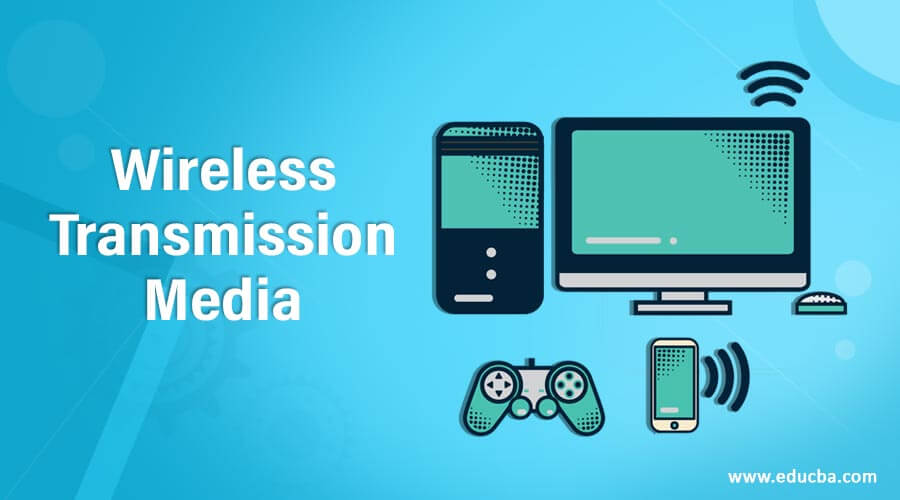Updated March 31, 2023

Introduction to Wireless Transmission Media
The mode of unguided media is wireless transmission. There is no physical link between two or more devices and wireless communication between wireless communications. Wireless signals are spread through the air and handled by suitable antennas. When an antenna is mounted on a device or wireless electrical circuit, the digital data is converted into radio signals and distributed all over its frequency spectrum. At the other end of the receiver, the signals are transmitted and translated to digital data. If you stand too far away from someone who wants to talk to you, you can’t hear what she says because the sound waves she emits don’t reach your ears. Wireless line-of – sight networking systems face similar limitations. When transmitting and receiving is separated too much for signals to enter, the communications route breaks down and the information-a power, data, or message signal-loses its destination.
How Does Wireless Transmission Media work?
Wireless media can send data through radio waves or infrared light on computers. Infrared is a wireless media that transmits infrarouge signals. Broadcast radio is a wireless medium that carries radio signals over long distances, such as between towns, areas, and countries and short distances, as in an office or at home. Mobility is a method of radio transmission that is commonly used for mobile communications, especially modems and mobile telephones. Microwaves are high-speed signal transmission radio waves. Satellite communications is an environment where microwave signals are emitted from an earth-based station, the signals are amplified and signals are distributed through a wide variety of earth-based stations.
Different types of Wireless Transmission Media are given as follows
- Light Transmission: Light or optical signalling is the strongest electromagnetic spectrum that can be used for data transmission. This is achieved by LASER. Owing to the use of frequency light, the sender and recipient must both be in the line of sight exclusively in straight lines. Since the laser transmission is one-way, the laser and the photodetector have to be located at both ends of the contact. The laser beam normally is 1 mm long so that two receptors are correctly matched to each Laser Source. Lasers cannot penetrate barriers like walls, rain, or thick nebulae. Laser beams are often deformed by heat, the temperature of the atmosphere, or changes in trajectory temperature.
- Infrared Transmission: In the visible spectrum of light and the microwaves, there is an infrared wave. The frequency range is from 300 GHz to 430 THz, and it has a wavelength of 700 NM to 1-mm. The infrared wave is used to communicate with very short distances like TV and remote contact. Infrared travels in a straight line and is thus inherently directional. Infrared is unable to penetrate wall-like barriers due to the high frequency spectrum.
- Microwave Transmission: Electromagnetic waves over 100 MHz can be transmitted directly and signals can be sent to a specific station by beaming the waves. Because microwaves are moving on a straight line, all transmitters and receivers must be strictly on an aligned line of view. The waves focus on microwave antennas to build a pulse. Multiple antennas can be aligned, as shown in the above image. Microwaves do not penetrate walls like barriers, they have a higher frequency.
- Radio Transmission: The wavelength ranges from 1 mm-100,000 km, and the frequency varies from 3 Hz (extremely low frequency) to 300 GHz (extra high frequency), and it can pass through the walls and structures of a region. Six bands separate radio frequencies. Low-frequency radio waves are able to pass through the walls, while higher radio frequencies can pass through in a straight line and rebound. Further power is given by High Frequency Radio Waves.
- Short Distance Wireless Media: This can promote contact between a few meters and a few miles or kilometres. Wireless networks are a regular phenomenon. Here are the types of wireless short distance communications:
- Bluetooth: Bluetooth uses a Personal area network such as cell phone connection, laptop connection, portable cameras, etc.
- Wi-max: Wi-Max reflects worldwide microwave connectivity interoperability. The network is established in the Metropolitan Area Network (MAN) and is covered by the Wi-Max. Cable TV and DSL Internet are examples.
Recommended Articles
This is a guide to Wireless Transmission Media. Here we also discuss the introduction and how does wireless transmission media work? along with an explanation. You may also have a look at the following articles to learn more –

